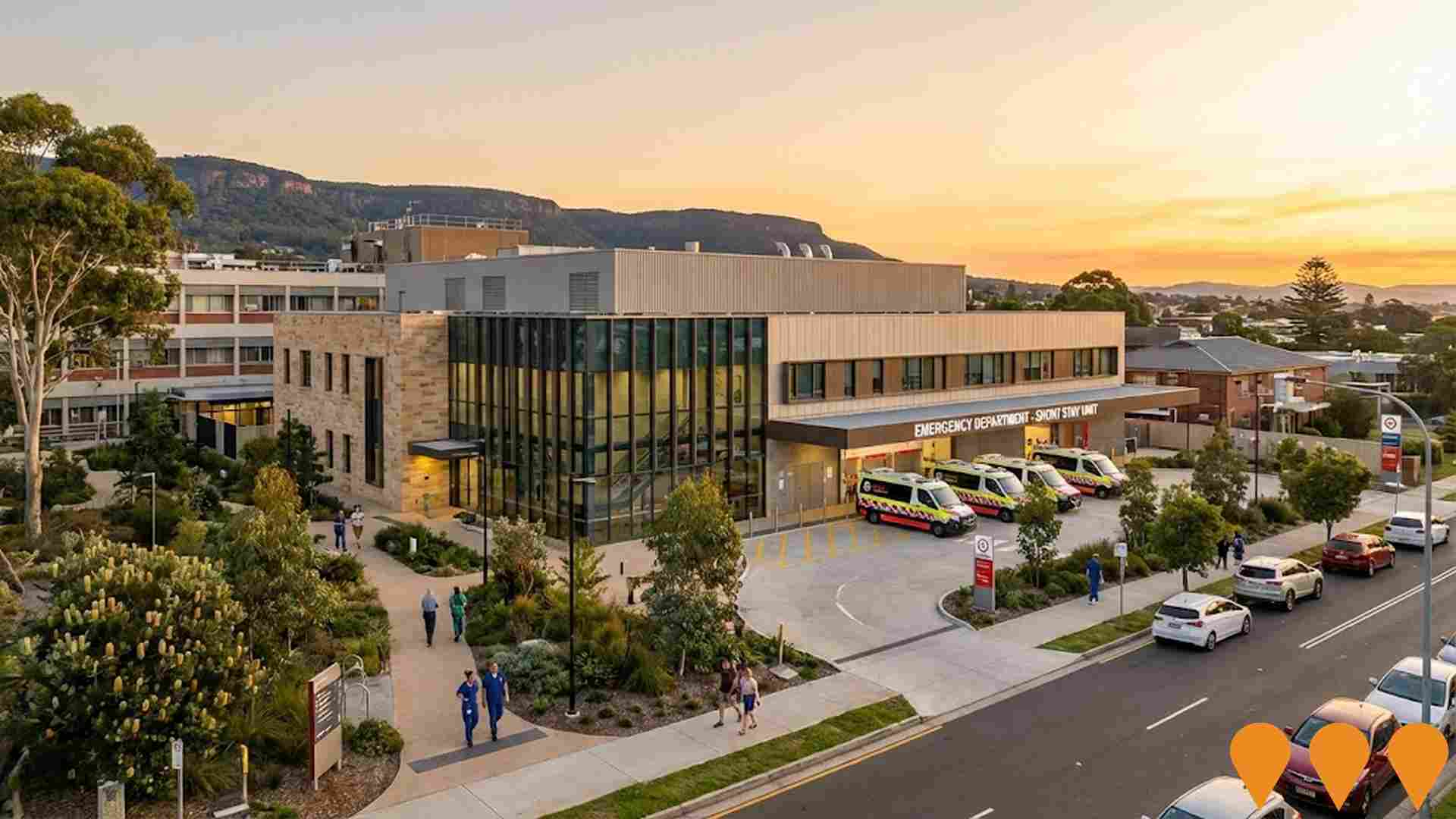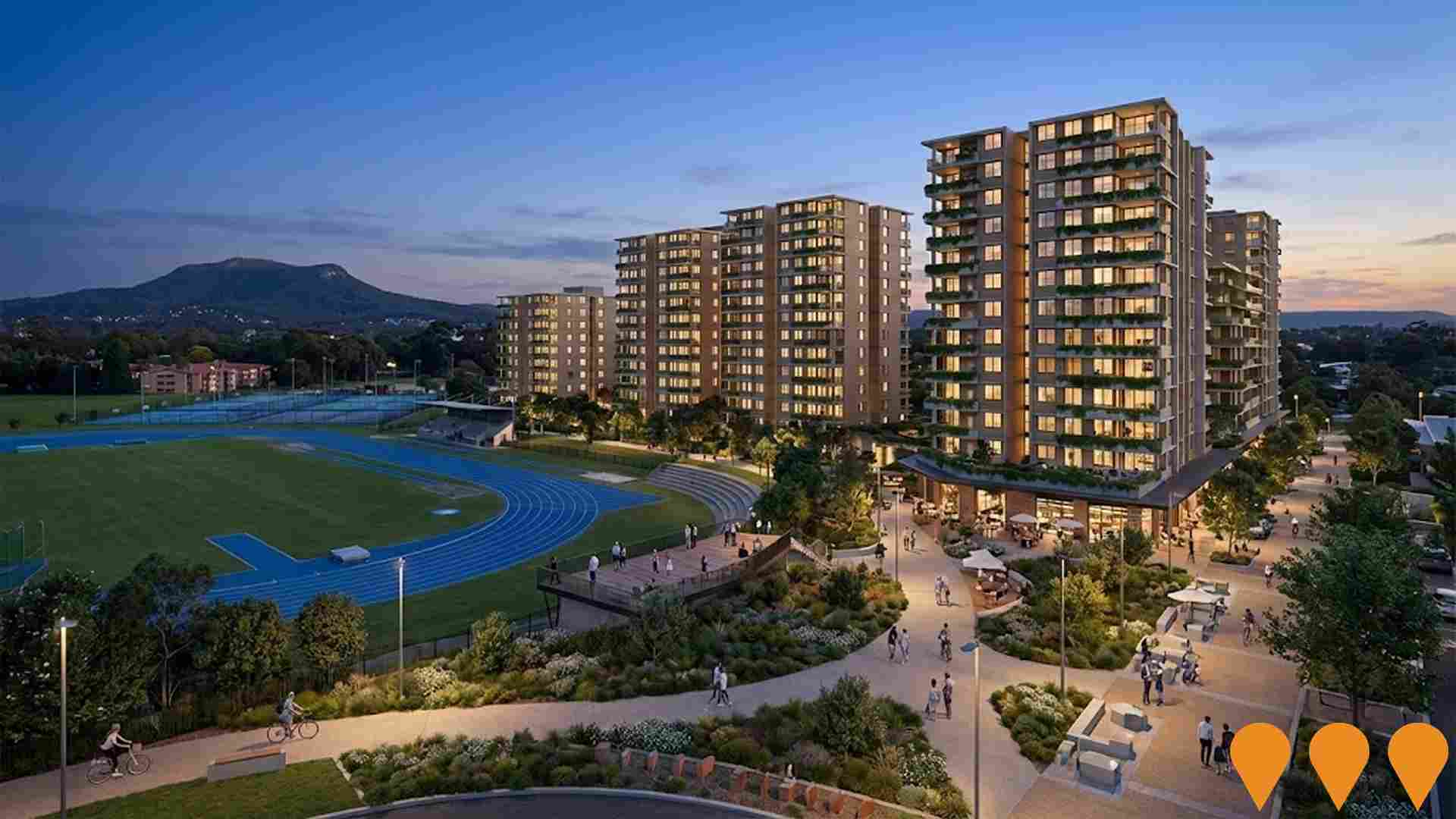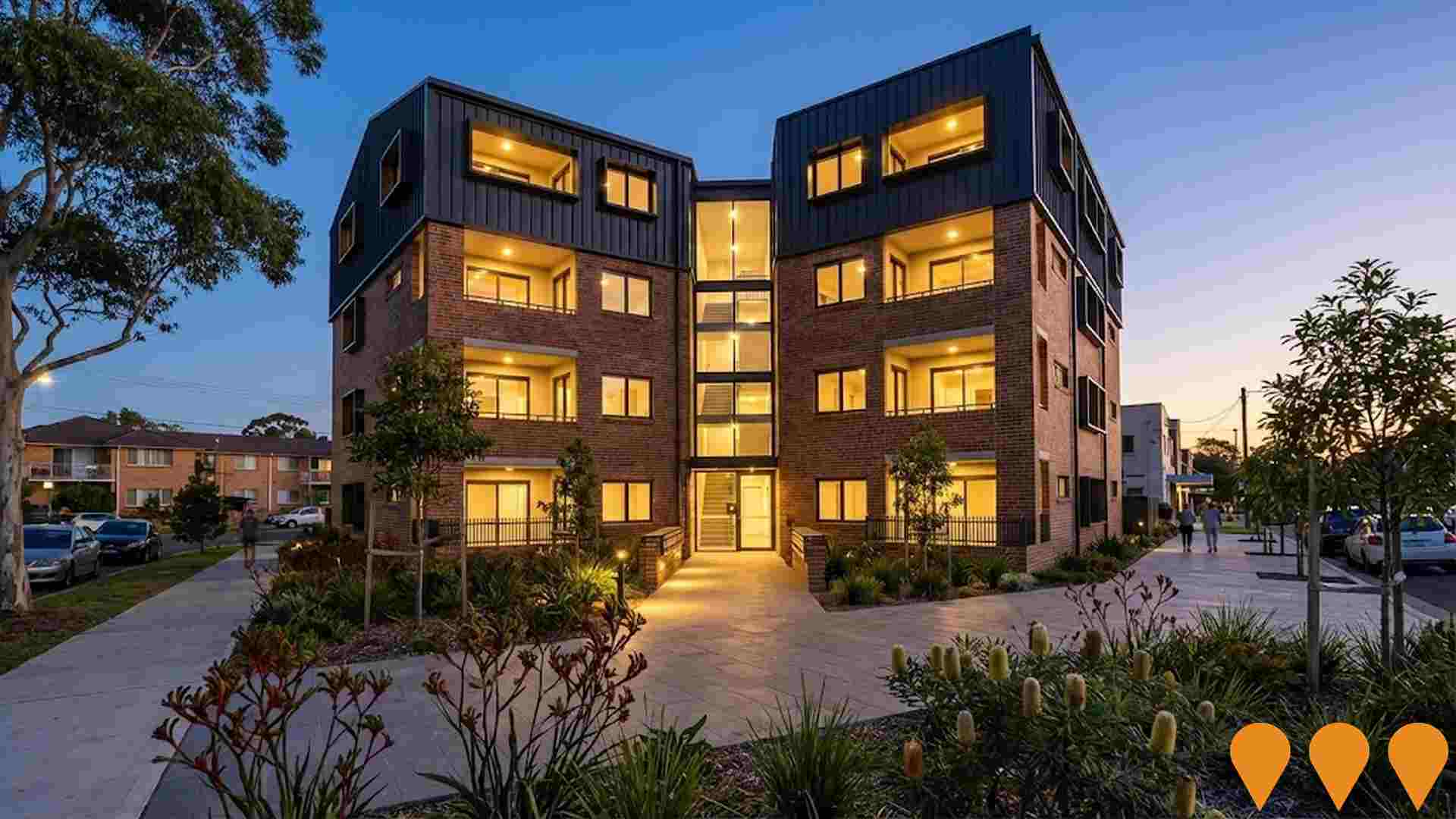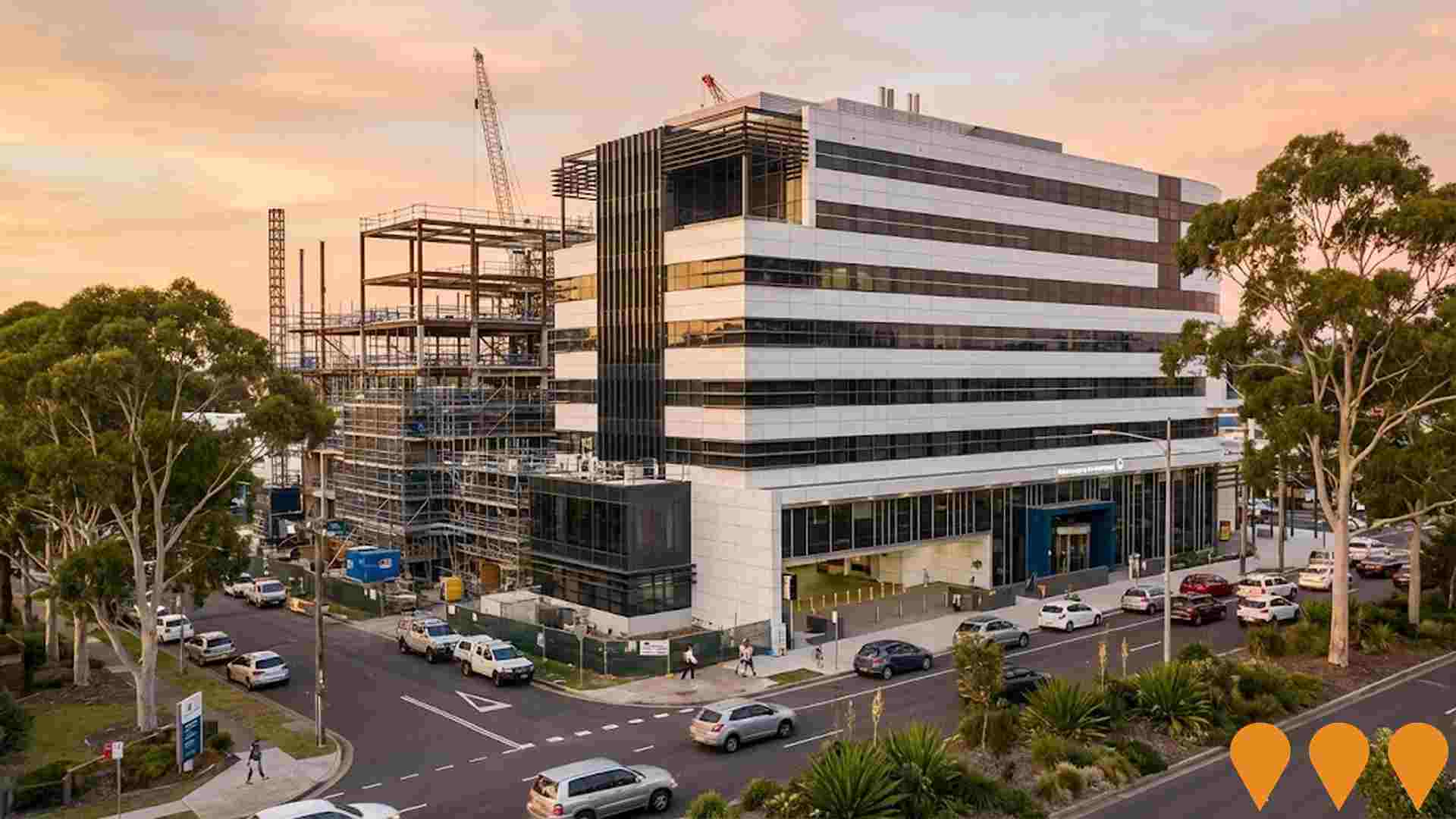Chart Color Schemes
est. as @ -- *
ABS ERP | -- people | --
2021 Census | -- people
Sales Activity
Curious about local property values? Filter the chart to assess the volume and appreciation (including resales) trends and regional comparisons, or scroll to the map below view this information at an individual property level.
Find a Recent Sale
Sales Detail
Population
Wollongong - West has seen population growth performance typically on par with national averages when looking at short and medium term trends
Wollongong - West's population was around 17,423 as of November 2025. This reflected an increase of 872 people since the 2021 Census, which reported a population of 16,551 people. The change was inferred from the estimated resident population of 17,352 in June 2024 and an additional 157 validated new addresses since the Census date. This level of population resulted in a density ratio of 3,078 persons per square kilometer, placing it in the upper quartile relative to national locations assessed by AreaSearch. Wollongong - West's growth of 5.3% since the 2021 census exceeded the SA3 area (4.0%) and the non-metro area, marking it as a growth leader in the region. Population growth was primarily driven by overseas migration contributing approximately 84.8% of overall population gains during recent periods.
AreaSearch adopted ABS/Geoscience Australia projections for each SA2 area, released in 2024 with 2022 as the base year. For areas not covered, NSW State Government's SA2 level projections were utilised, released in 2022 with 2021 as the base year. Growth rates by age group from these aggregations were applied to all areas for years 2032 to 2041. Based on demographic trends and latest population numbers, a significant increase is forecasted for Wollongong - West in the top quartile of regional areas across the nation, with an expected growth of 6,000 persons by 2041, recording a gain of 34.0% in total over the 17 years.
Frequently Asked Questions - Population
Development
AreaSearch analysis of residential development drivers sees Wollongong - West recording a relatively average level of approval activity when compared to local markets analysed countrywide
Wollongong - West has seen approximately 81 new homes approved annually. Between FY21 and FY25408 homes were approved, with an additional 4 approved so far in FY26. Over these years, on average, only 0.2 people moved to the area per dwelling built.
This suggests that new supply has kept pace with or exceeded demand, providing ample buyer choice and capacity for population growth beyond current forecasts. The average construction cost of new properties is $370,000. In FY26, commercial development approvals totalled $28.3 million, indicating high local commercial activity. Comparatively, Wollongong - West has 17.0% less new development per person than the Rest of NSW and ranks at the 49th percentile nationally. This results in relatively constrained buyer choice, supporting interest in existing dwellings.
New building activity consists of 20.0% detached houses and 80.0% medium to high-density housing. This shift from the area's current 48.0% houses indicates decreasing availability of developable sites and reflects changing lifestyles and demand for affordable housing options. With around 336 people per dwelling approval, Wollongong - West is characterized as a low density area. Population forecasts project an increase of 5,929 residents by 2041. At current development rates, housing supply may struggle to match population growth, potentially intensifying buyer competition and supporting price increases.
Frequently Asked Questions - Development
Infrastructure
Wollongong - West has strong levels of nearby infrastructure activity, ranking in the top 30% nationally
AreaSearch has identified 28 projects that could impact the area, with key ones including Wollongong Hospital Redevelopment - Planning and Equipment Upgrades, Wollongong Health Precinct Strategy, Wollongong Hospital ED Short Stay Units, and Kenny Street Mixed-Use Tower. The following list details those most likely to be relevant.
Professional plan users can use the search below to filter and access additional projects.
INFRASTRUCTURE SEARCH
 Denotes AI-based impression for illustrative purposes only, not to be taken as definitive under any circumstances. Please follow links and conduct other investigations from the project's source for actual imagery. Developers and project owners wishing us to use original imagery please Contact Us and we will do so.
Denotes AI-based impression for illustrative purposes only, not to be taken as definitive under any circumstances. Please follow links and conduct other investigations from the project's source for actual imagery. Developers and project owners wishing us to use original imagery please Contact Us and we will do so.
Frequently Asked Questions - Infrastructure
Irvine Street Gwynneville Precinct Planning Proposal
Planning Proposal lodged by Homes NSW to rezone the precinct for urban renewal, enabling up to 1,250 homes (3-6 storeys), with 50% dedicated to social and affordable housing, and new public open space. The proposal is currently under public exhibition and assessment by Wollongong City Council after receiving a Gateway Determination from the NSW Department of Planning, Housing and Infrastructure.
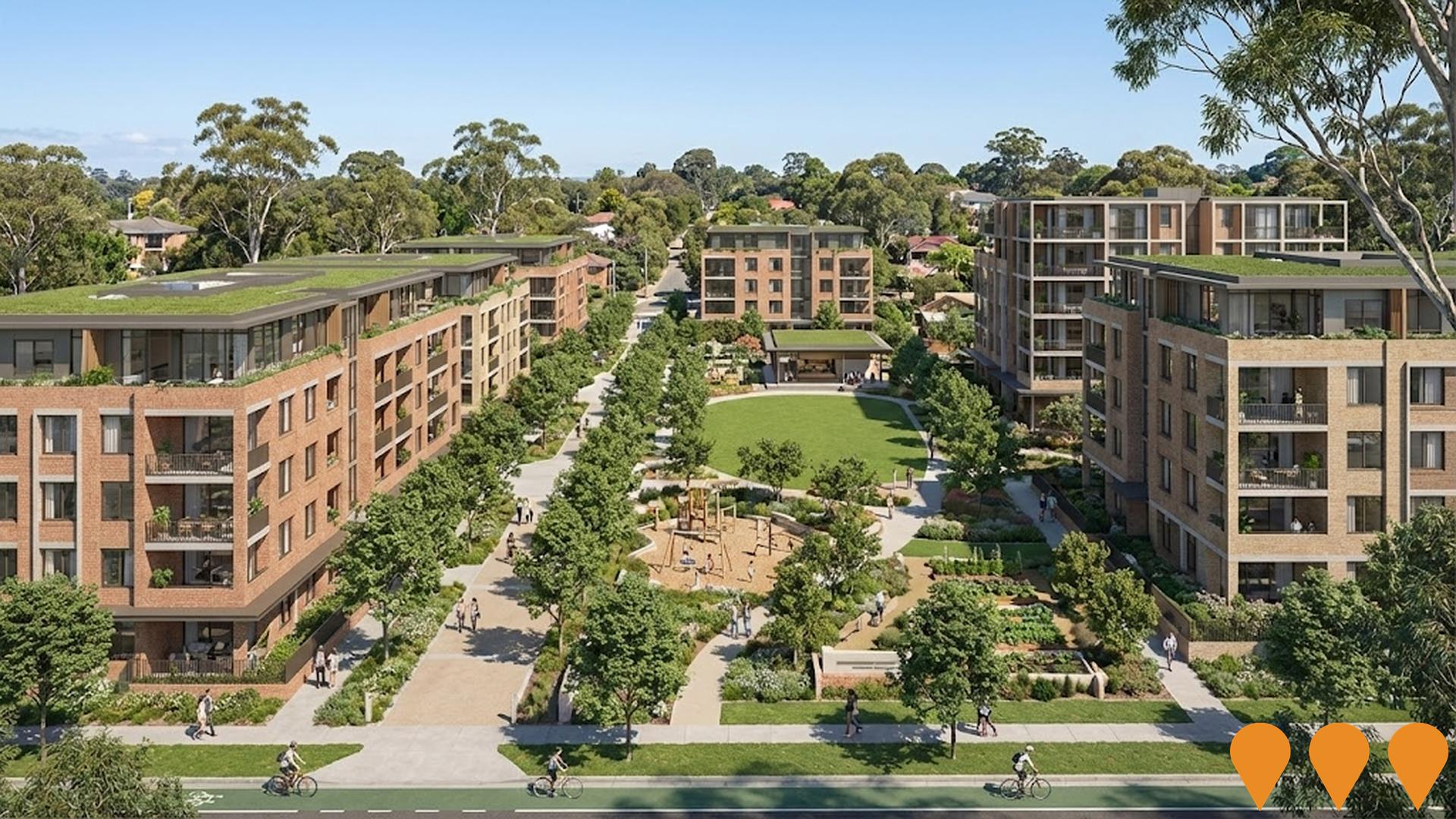
Wollongong Hospital Redevelopment - Planning and Equipment Upgrades
NSW Government has committed $21.9 million to upgrade and expand Wollongong Hospital, including installation of an additional MRI and CT scanner, relocation and expansion of the Medical Ambulatory Care (MAC) unit, and expansion/relocation of the Emergency Short Stay Area (ESSA) to improve patient flow. Construction commenced in February 2025 with works expected to complete in early 2026. The package also funds early planning for a broader future redevelopment.

Illawarra Renewable Energy Zone (REZ)
NSW's first urban Renewable Energy Zone with an intended network capacity of 1 GW (potential to increase). Integrates consumer energy resources including rooftop solar, home batteries, and community-scale batteries while leveraging existing port, transport and grid assets to support low-carbon industries such as offshore wind, green hydrogen, and green steel manufacturing. The May 2025 Illawarra REZ Roundtable and Registration of Interest process attracted 44 projects worth over $43 billion in potential investment (including offshore wind, solar, energy storage, pumped hydro, and hydrogen). EnergyCo is the infrastructure planner, coordinating transmission upgrades in partnership with Endeavour Energy.
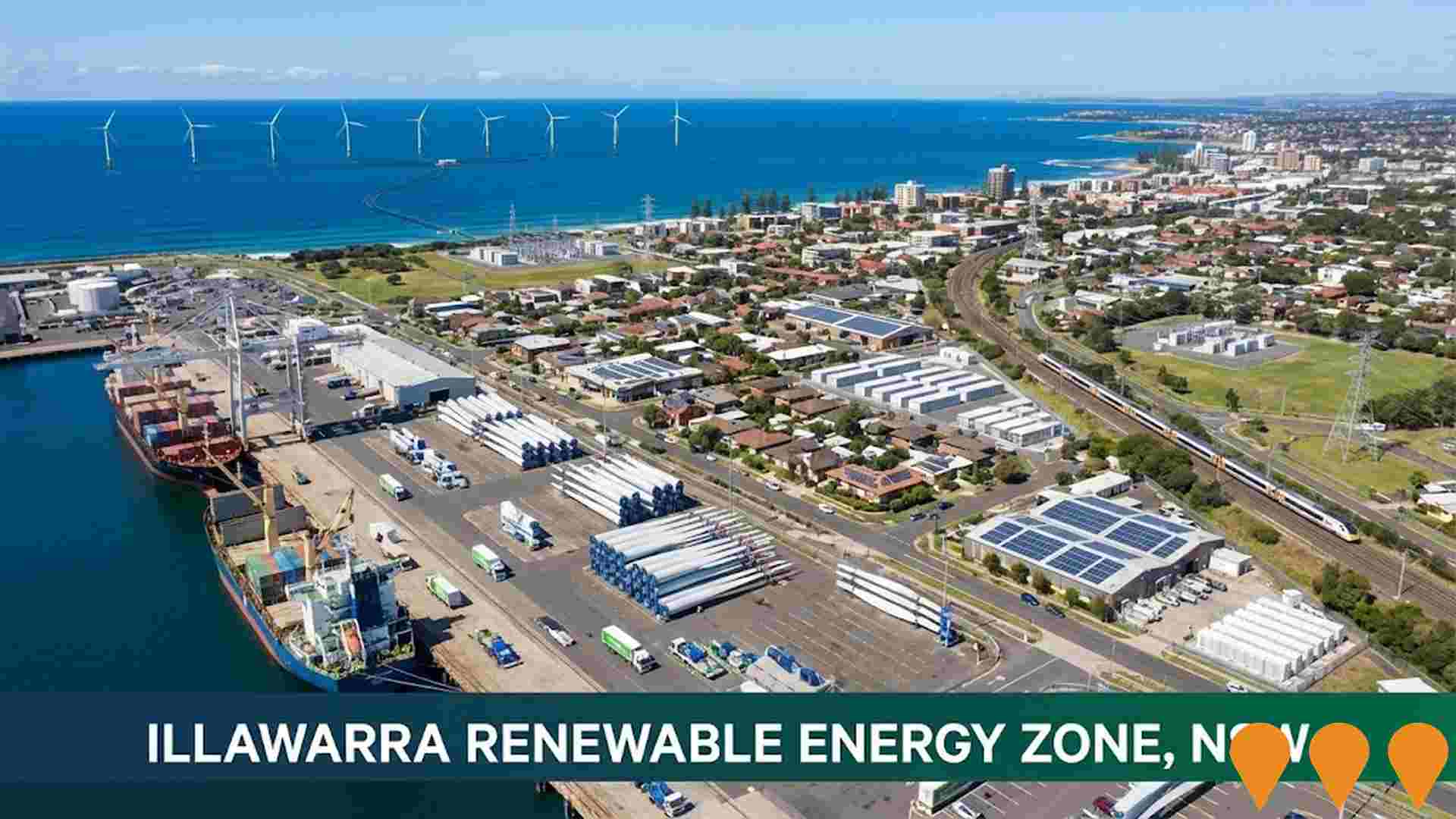
Adria Village Figtree
A $50 million Croatian-community focused seniors living precinct featuring a 102-bed residential aged care facility and 22 independent living units. Approved by the Land & Environment Court in May 2025 following redesign to resolve flooding and bulk/scale concerns. Site preparation and early works commenced in September 2025 with main construction now underway.
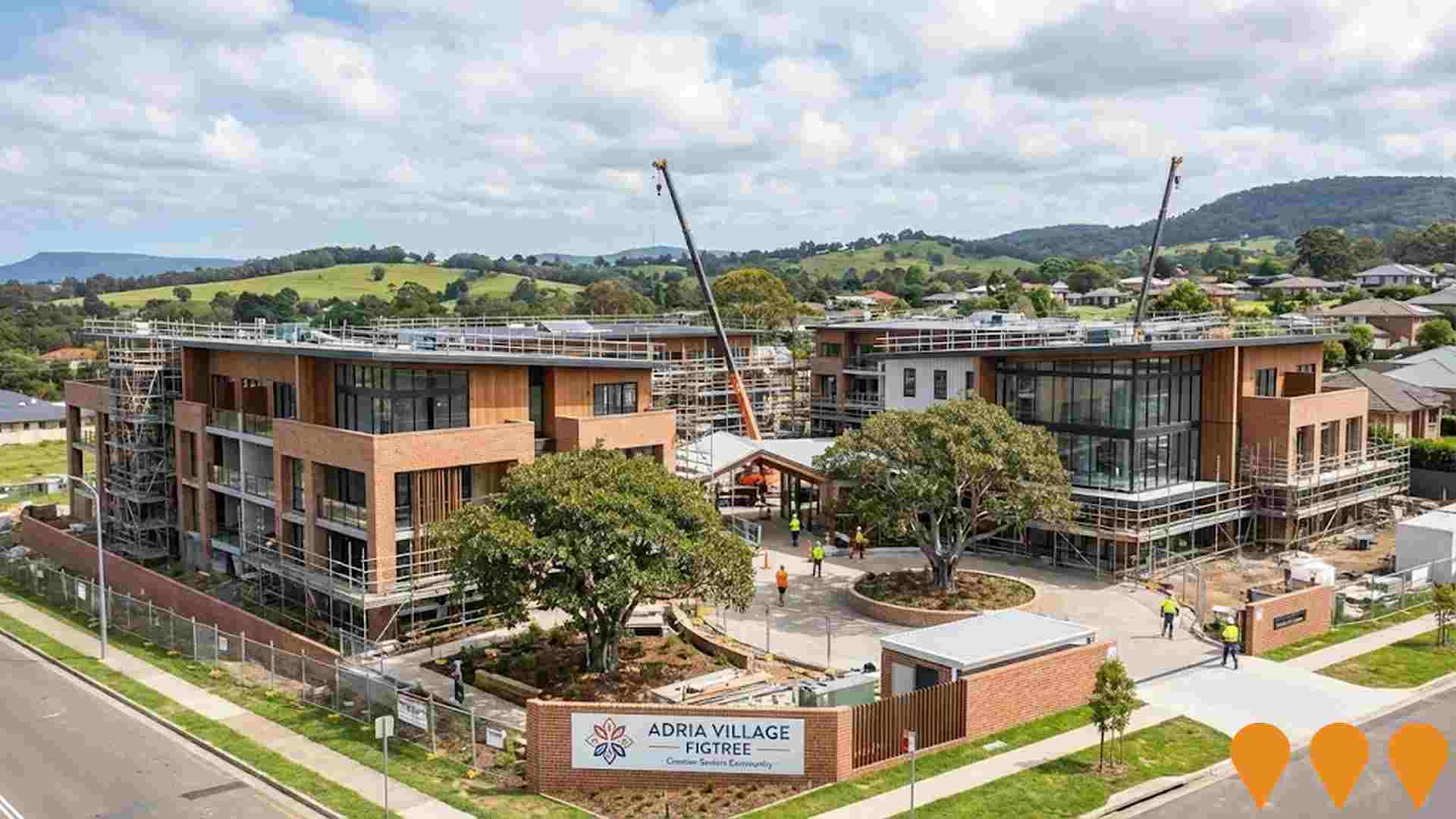
Wollongong to Coniston Rail Infrastructure Upgrade
The project involves duplicating approximately 3.5 km of track between Wollongong and Coniston, upgrading Wollongong and Coniston stations (new platforms, lifts, and accessibility improvements), new signalling, and associated infrastructure to allow more frequent and reliable train services on the South Coast Line.
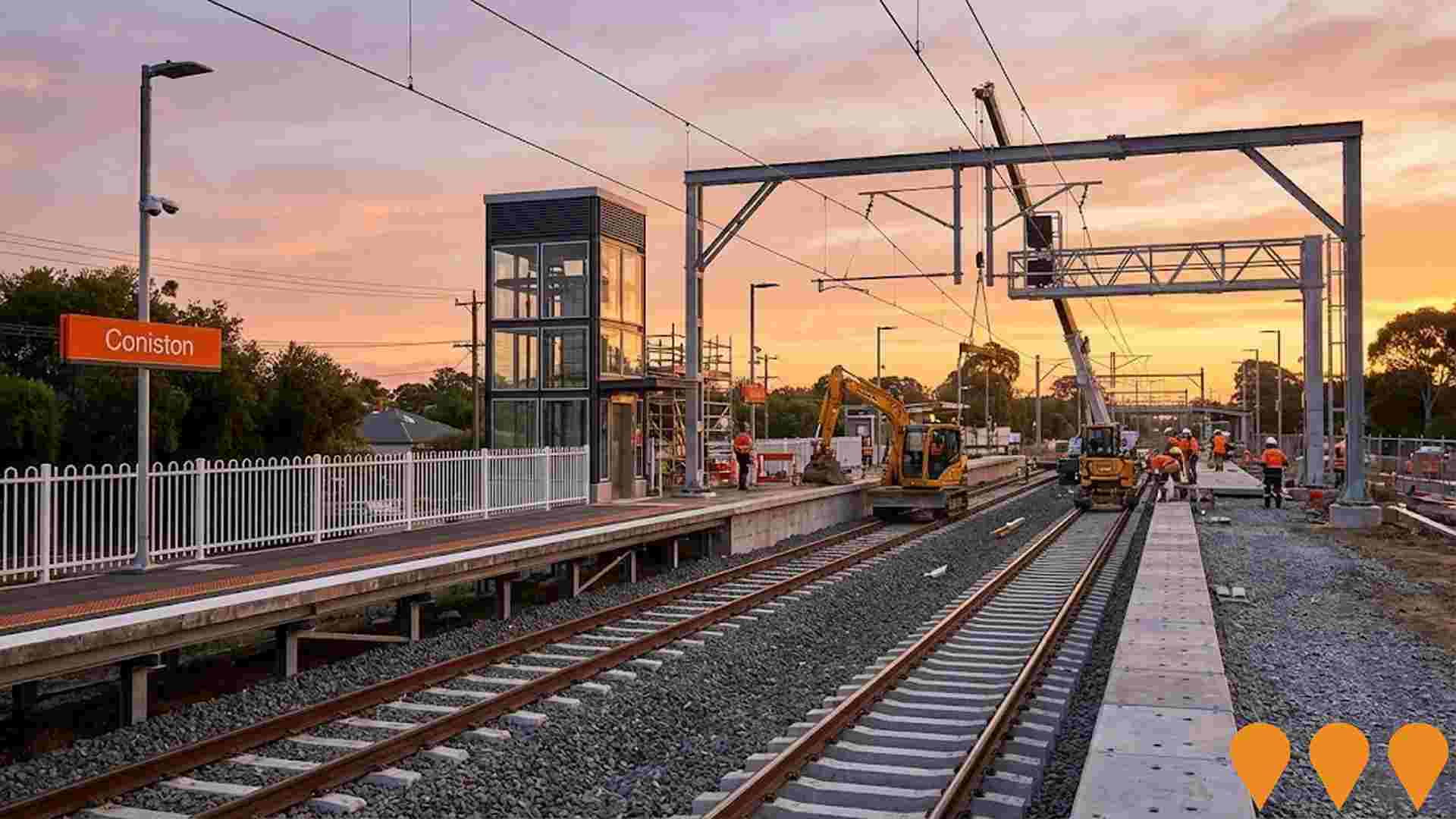
Wollongong Station Master Plan
The Wollongong Station Master Plan is a Transport for NSW initiative to transform Wollongong Railway Station into a modern integrated transport hub. The project includes a new transport interchange, upgraded station facilities, improved pedestrian and cyclist access, commercial and retail opportunities, and enhanced public domain to support urban renewal in the Wollongong city centre.

Wollongong Health Precinct Strategy
Place-based strategy to guide future development of the Wollongong Health Precinct west of Wollongong CBD. Includes expansion of health facilities, affordable housing for key workers, and improved transport links.
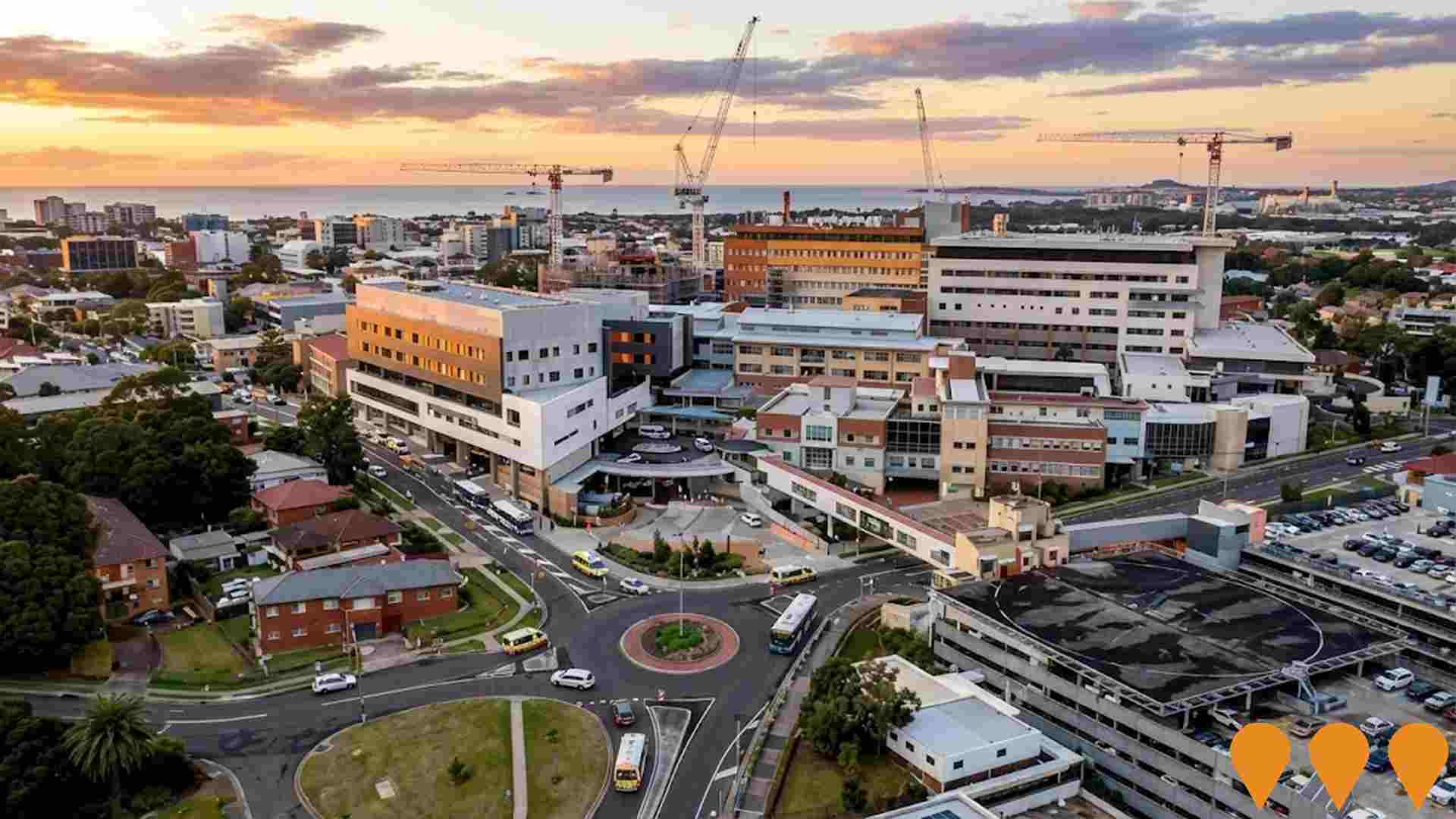
Gwynneville Renewal Project
Major urban renewal project to transform the Gwynneville precinct into a high-density residential area with up to 1,250 homes. The project will deliver 625 social and affordable dwellings (50%) and 625 market housing dwellings, including diverse housing types for seniors, students, and key workers. The Planning Proposal seeks to rezone most of the precinct from R2 Low Density Residential to R4 High Density Residential, with buildings ranging from 3-6 storeys. Public exhibition concluded May 5, 2025, following Gateway determination issued January 12, 2025. This long-term staged development will increase zoned open space from 0.83ha to 1.39ha and create 27 key development sites across the 131-lot precinct.
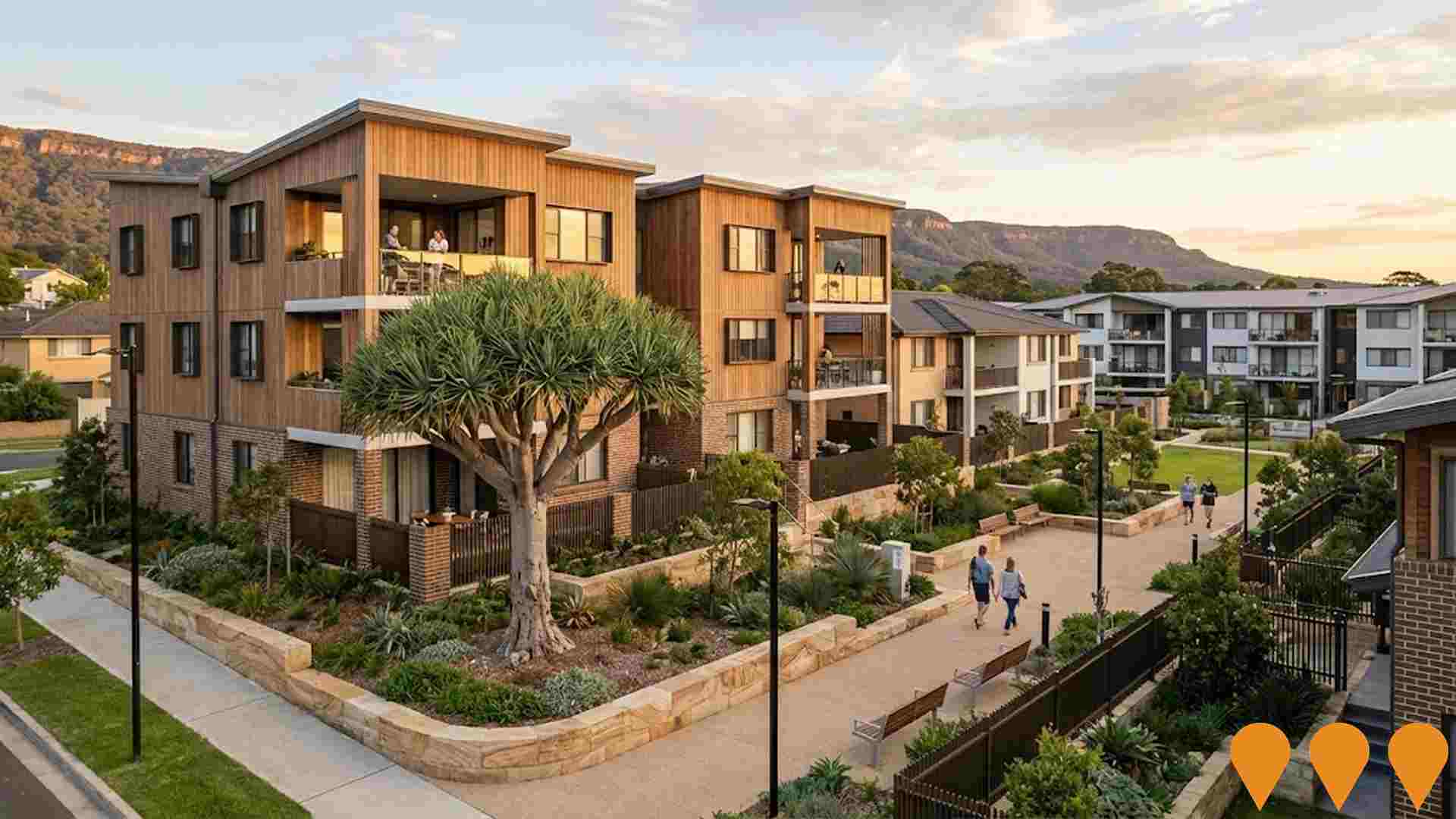
Employment
AreaSearch assessment indicates Wollongong - West faces employment challenges relative to the majority of Australian markets
Wollongong-West has a well-educated workforce with significant representation in essential services sectors. The unemployment rate as of June 2025 was 7.2%.
Over the past year, there was an estimated employment growth of 0.7%. As of June 2025, 9,190 residents were employed while the unemployment rate was 3.6% higher than Rest of NSW's rate of 3.7%, indicating potential improvement areas. Workforce participation was at 60.9%, slightly higher than Rest of NSW's 56.4%.
Leading employment industries among residents included health care & social assistance, education & training, and retail trade, while agriculture, forestry & fishing had lower representation at 0.3% compared to the regional average of 5.3%. Employment opportunities exist locally but many residents commute elsewhere for work based on Census data. Between June 2024 and June 2025, employment increased by 0.7%, labour force grew by 0.5%, leading to a slight decrease in unemployment rate by 0.1 percentage points. In comparison, Rest of NSW saw an employment decline of 0.1% with unemployment rising by 0.4 percentage points during the same period. Jobs and Skills Australia's national employment forecasts from May 2025 project overall employment growth of 6.6% over five years and 13.7% over ten years, but growth rates vary significantly between industries. Applying these projections to Wollongong-West's employment mix suggests local growth of approximately 6.9% over five years and 14.4% over ten years, though these are simple extrapolations for illustrative purposes and do not account for local population changes.
Frequently Asked Questions - Employment
Income
Income levels sit below national averages according to AreaSearch assessment
AreaSearch's latest postcode level ATO data for financial year 2022 shows income in Wollongong - West is below the national average. The median income is $45,231 while the average stands at $61,814. This contrasts with Rest of NSW's figures where the median income is $49,459 and the average is $62,998. Based on Wage Price Index growth of 12.61% since financial year 2022, current estimates for Wollongong - West would be approximately $50,935 (median) and $69,609 (average) as of September 2025. According to the 2021 Census, household, family, and personal incomes in Wollongong - West rank modestly between the 39th and 41st percentiles. Income brackets indicate that the largest segment comprises 31.0% earning $1,500-$2,999 weekly (5,401 residents), aligning with the surrounding region where this cohort likewise represents 29.9%. Housing affordability pressures are severe in Wollongong - West, with only 81.2% of income remaining, ranking at the 39th percentile. The area's SEIFA income ranking places it in the 6th decile.
Frequently Asked Questions - Income
Housing
Wollongong - West displays a diverse mix of dwelling types, with a higher proportion of rental properties than the broader region
In Wollongong - West, as per the latest Census, 47.8% of dwellings were houses while 52.2% consisted of other types such as semi-detached homes, apartments and 'other' dwellings. This compares to Non-Metro NSW where 58.9% of dwellings were houses and 41.1% were other dwellings. Home ownership in Wollongong - West stood at 26.7%, with mortgaged dwellings at 25.6% and rented ones at 47.7%. The median monthly mortgage repayment was $2,000, lower than Non-Metro NSW's average of $2,189. Median weekly rent in Wollongong - West was $380, compared to $400 in Non-Metro NSW. Nationally, Wollongong - West's mortgage repayments were higher at $2,000 than the Australian average of $1,863, while rents were also higher at $380 compared to the national figure of $375.
Frequently Asked Questions - Housing
Household Composition
Wollongong - West features high concentrations of group households, with a lower-than-average median household size
Family households constitute 59.6% of all households, including 24.4% couples with children, 23.9% couples without children, and 9.8% single parent families. Non-family households account for the remaining 40.4%, with lone person households at 29.8% and group households comprising 10.6%. The median household size is 2.4 people, which is smaller than the Rest of NSW average of 2.5.
Frequently Asked Questions - Households
Local Schools & Education
The educational profile of Wollongong - West exceeds national averages, with above-average qualification levels and academic performance metrics
Educational attainment in Wollongong - West is notably higher than broader benchmarks. As of 2016, 36.9% of residents aged 15 and above held university qualifications, compared to 21.3% in the rest of NSW and 25.2% in the SA4 region. Bachelor degrees were the most common at 23.4%, followed by postgraduate qualifications (10.8%) and graduate diplomas (2.7%). Vocational credentials were also prominent, with 29.8% of residents holding such qualifications - advanced diplomas (9.7%) and certificates (20.1%).
Educational participation was high, with 34.0% of residents currently enrolled in formal education as of 2016. This included 13.0% in tertiary education, 7.4% in primary education, and 6.1% pursuing secondary education. As of 2020, a robust network of 9 schools operated within Wollongong - West, educating approximately 2,407 students. The area demonstrated above-average socio-educational conditions with an ICSEA score of 1057. The educational mix included 6 primary and 3 K-12 schools.
Frequently Asked Questions - Education
Schools Detail
Nearby Services & Amenities
Transport
Transport servicing is high compared to other areas nationally based on assessment of service frequency, route connectivity and accessibility
Wollongong-West has 127 active public transport stops. These are served by 61 routes offering a total of 5441 weekly passenger trips. The average distance to the nearest stop for residents is 139 meters.
On average, there are 777 trips per day across all routes, equating to approximately 42 weekly trips per individual stop.
Frequently Asked Questions - Transport
Transport Stops Detail
Health
Wollongong - West's residents are healthier than average in comparison to broader Australia with a fairly standard level of common health conditions seen across both young and old age cohorts
Wollongong - West residents show relatively positive health outcomes, with standard common health conditions seen across both young and old age groups. Approximately 51% (~8,816 people) have private health cover, compared to 56.6% across Rest of NSW.
Mental health issues affect 10.2% of residents, while arthritis impacts 7.2%. About 69.5% declare themselves completely clear of medical ailments, compared to 68.6% in Rest of NSW. The area has 13.6% (2,369 people) aged 65 and over, lower than the 17.7% in Rest of NSW. This aligns with the general population's health profile.
Frequently Asked Questions - Health
Cultural Diversity
Wollongong - West was found to be more culturally diverse than the vast majority of local markets in Australia, upon assessment of a range of language and cultural background related metrics
Wollongong-West has a higher cultural diversity than most local areas, with 32.4% of its population born overseas and 30.2% speaking a language other than English at home. Christianity is the predominant religion in Wollongong-West, accounting for 49.2% of the population. However, Islam is notably overrepresented, comprising 4.6% compared to the regional average of 2.5%.
The top three ancestry groups are English (22.0%), Australian (21.0%), and Other (12.3%). Some ethnic groups show significant differences: Macedonian at 4.2% versus the regional 1.5%, Serbian at 2.2% versus 0.8%, and Croatian at 1.0% versus 0.7%.
Frequently Asked Questions - Diversity
Age
Wollongong - West hosts a young demographic, positioning it in the bottom quartile nationwide
The median age in Wollongong-West is 33 years, considerably lower than Rest of NSW's average of 43 and substantially under the national average of 38. Compared to Rest of NSW, the 25-34 cohort is notably over-represented at 22.3% locally, while the 65-74 age group is under-represented at 7.0%. This concentration of the 25-34 age group is well above the national average of 14.5%. Post-2021 Census data shows the 25 to 34 age group has grown from 19.0% to 22.3%, while the 45 to 54 cohort has declined from 11.7% to 10.2%. Population forecasts for 2041 indicate substantial demographic changes in Wollongong-West, with the 25-34 age group expected to grow by 59% (2,296 people), reaching 6,184 from 3,887.
